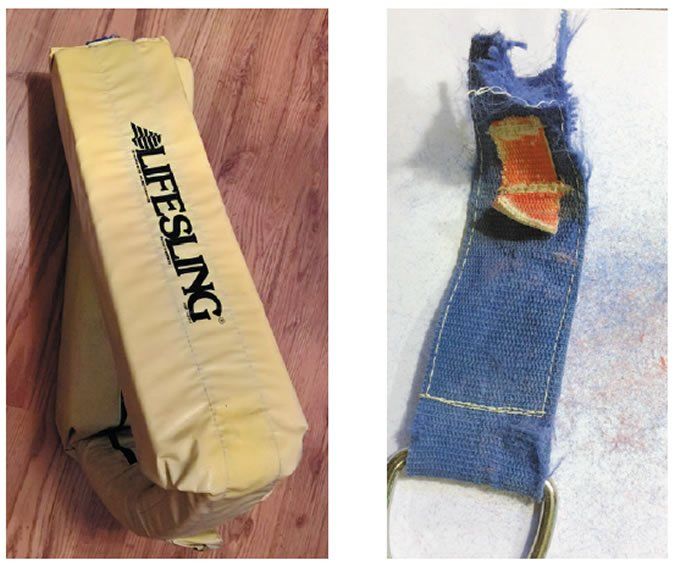I recently inspected our Lifesling MOBrescue device. The webbing beckets that attached the polypropylene float line to the horseshoe float had deteriorated. These strapstore free from the float with only about 40 pounds of pressure. The Lifesling came with our boat, so I don’t know how old it is or how it had been stored previously, although I do know it was stored in a translucent, polyethylene hard case for a while.
This safety issue deserves a recall, in my opinion, and highlights the need to periodically inspect safety equipment.
Court Smith
Dragon Lady, 41 Morgan Classic
Warner Robins, Ga.

As you noted, this is a great reminder that owners should inspect safety gear regularly. In addition to an annual visual inspection, we recommend running annual or bi-annual man-overboard drills with onboard rescue aids like the Lifesling and other throwables.
While your inherited Lifeslings failure does call into question the devices usable lifespan, it appears that yours spent quite a while either stored without a case and fully exposed to UV; stored in a damaged case that allowed in UV; or improperly stored (upside down) in its case, with the bottom of the float exposed to the elements. This is not surprising given that the flimsy storage bags the original Lifesling was sold with are notorious for falling apart, and replacements are not cheap. A translucent case seemingly would allow UV through as well, so it could have been a factor in the webbing beckets demise.
We have a Lifesling2 aboard one PS test boat thats nearly 20 years old; while the original case its always stored in has been doctored over time and is now on its last leg, the Lifesling2 float, webbing beckets, and poly float line are in pristine condition.
Developed by The Sailing Foundation (www.thesailingfoundation.org), Lifeslings have been in production for almost 40 years. The Lifesling in your photos appears to be quite old and likely was the original model, which is no longer in production. It is interesting to note that the webbing stitching on your inherited Lifesling was more UV resistant than the webbing that failed, which leads us to believe that the webbing used in that era of Lifesling was very poor quality. Its possible that this Lifesling was produced before the design earned U.S. Coast Guard (USCG) approval.
Current Lifeslings, approved as Type IV (throwable) or Type V (special use) flotation devices, use the same polypropylene webbing commonly used on personal flotation devices (PFDs) and have all been tested to meet the webbing requirements for USCG-approved PFDs, according to Lifesling distributor West Marine. This includes a minimum strength and resistance to things like weathering, explained Steve Miller, West Marines safety category manager.
Polypropylene webbings UV resistance and longevity can vary greatly; some studies have shown that it can lose 20 to 75 percent of its strength per year. Compare this to the nylon webbing that Lifesling uses to protect the length of line that attaches the float to the boat: Nylon webbing loses about 10 percent of its strength per year, while polyester webbing loses only about 5 percent per year. This makes us wonder why Lifesling would not use the more durable and UV-resistant nylon or polyester webbing for the beckets. However, the device is designed so that the beckets are not exposed to UV when its stored properly in a good-condition bag or rigid case.
The Lifesling owners manual does not offer a timeframe for regular maintenance, inspection, or replacement, and the devices longevity would be dependent upon a number of factors, including how it is stored, how often its used, and the environmental conditions where its stored. Hence the need for regular inspection, just as you would a PFD, and regular drills to determine whether the Lifesling can still handle the load of lifting crew.

Recommendations
-Inspect Lifeslings of any age for UV damage (beckets, stitching, webbing tether, poly float line, horeshoe float); animal damage (the poly line makes a nice chew toy for squirrels and mice); or potential weak spots. Any degradation requires that the whole device be replaced.
-Load test the Lifesling regularly, especially if yours is an older model or if you plan to take it offshore.
-Pay close attention to the health of the storage bag or case. This is the most common Lifesling failure point. The bags Velcro closure often allows gapping in the top that can leave the float exposed to UV; consider replacing the Velcro with a closure that does not allow gapping. OEM replacement bags ($50) are not high-quality or durable, in our opinion; Sunbrella bags ($80) are a better choice; rigid cases ($220) are the most durable option and are recommended for offshore use.
-Unpack and repack the Lifesling annually. Be sure that all critical parts are protected from the sun. For a good how-to on packing the Lifesling properly, visit http://theboatgalley.com/is-your-lifesling-ready-for-use-are-you-sure/.








































